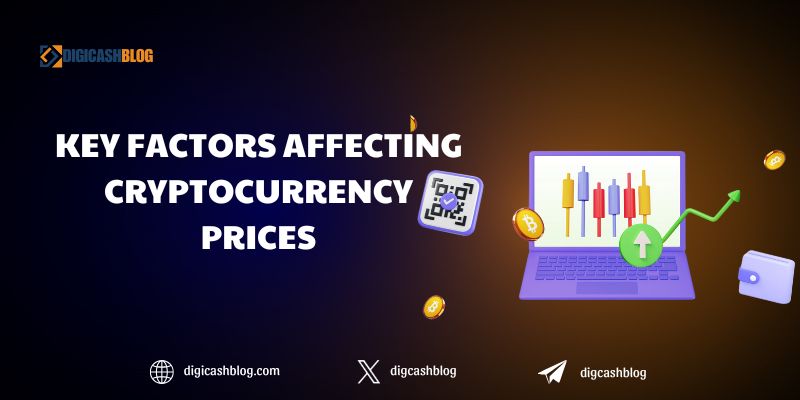Introduction to Cryptocurrency Price Dynamics
The cryptocurrency market, valued at $2.66 trillion in 2025, remains a dynamic and volatile space driven by a complex interplay of factors. Understanding the key factors affecting cryptocurrency prices in 2025 is essential for traders and investors aiming to navigate this rapidly evolving landscape. From macroeconomic trends to on-chain metrics and regulatory shifts, these factors shape price movements across assets like Bitcoin, Ethereum, and altcoins. This article explores the primary drivers of crypto prices, integrating technical and fundamental analysis to provide actionable insights.

Macroeconomic and Market Sentiment Factors
Macroeconomic conditions significantly influence cryptocurrency prices, as they do traditional markets:
-
Global Economic Policies: Interest rate decisions by central banks, such as the U.S. Federal Reserve, impact crypto valuations. In Q1 2025, U.S. trade tariffs caused a temporary Bitcoin price dip from $108,786, as noted in X posts, reflecting sensitivity to macroeconomic shifts.
-
Market Sentiment: Social media platforms like X amplify sentiment-driven price movements. Speculative hype around memecoins like Dogecoin, fueled by community posts, often leads to short-term price spikes, while negative sentiment can trigger sell-offs.
-
Institutional Adoption: The influx of institutional capital through Bitcoin ETFs (e.g., BlackRock’s $15 billion in assets) and corporate treasury allocations (e.g., MicroStrategy) bolsters demand, driving prices higher. This trend is expected to continue in 2025, supporting Bitcoin and Ethereum.
Regulatory Developments
Regulatory clarity is a pivotal factor shaping crypto prices in 2025:
-
Pro-Crypto Policies: The U.S. administration’s repeal of the IRS’s DeFi broker rule and appointment of crypto-friendly regulators have boosted investor confidence, as highlighted in X discussions. This has supported price stability for assets like XRP and stablecoins.
-
Global Regulatory Frameworks: The EU’s Markets in Crypto-Assets (MiCA) regulation, while increasing compliance costs, provides a structured environment, encouraging institutional participation. Conversely, regulatory crackdowns in some regions can suppress prices, as seen with altcoins in restrictive jurisdictions.
-
Impact on Prices: Clear regulations attract capital inflows, while uncertainty can lead to volatility. For instance, South Africa’s 2025 exchange control regulations integrating digital assets have spurred local adoption, lifting prices for tokens like Solana.
On-Chain Metrics and Network Activity
On-chain analysis, as discussed previously, provides critical insights into price drivers:
-
Transaction Volume and Active Addresses: High on-chain transaction volumes and active addresses indicate strong network usage. For example, Ethereum’s 1.2 million daily active addresses in Q1 2025 signal robust DeFi adoption, supporting price growth.
-
Exchange Flows: Net outflows from exchanges, such as $1 billion in Bitcoin moved to cold wallets in early 2025, suggest accumulation and bullish sentiment, driving prices higher. Conversely, inflows often precede sell-offs.
-
HODL Waves: On-chain data showing long-term holding (e.g., Bitcoin’s HODL Waves indicating unspent coins) reflects investor confidence, stabilizing or boosting prices.
-
Application: Traders use tools like Glassnode to monitor these metrics, combining them with technical indicators to predict trends.
Technical Analysis and Market Dynamics
Technical indicators, as covered in prior articles, play a significant role in price movements:
-
Moving Averages (MA): The 50-day and 200-day Simple Moving Averages (SMA) help identify trends. A Golden Cross (50-day SMA crossing above 200-day SMA) in Bitcoin’s chart in 2024 preceded a rally, signaling bullish momentum.
-
Volume Analysis: High trading volume validates price breakouts. For instance, a Solana price surge above resistance with spiking volume confirms a sustainable uptrend, while low volume may indicate a false breakout.
-
RSI and Bollinger Bands: Overbought (RSI > 70) or oversold (RSI < 30) conditions, combined with price interactions at Bollinger Bands, help predict reversals. For example, a high-volume touch of the lower Bollinger Band with an oversold RSI in Cardano could signal a buying opportunity.

Technological Advancements and Ecosystem Growth
Technological developments drive long-term price appreciation:
-
Layer 1 and Layer 2 Solutions: Innovations in Layer 1 blockchains (e.g., Solana’s $0.00025 transaction fees) and Layer 2 scaling solutions (e.g., Optimism, Arbitrum) enhance network efficiency, boosting adoption and prices. Ethereum’s Layer 2 TVL is projected to hit $200 billion by year-end.
-
DeFi and RWA Tokenization: The growth of DeFi (e.g., Uniswap, Aave) and real-world asset (RWA) tokenization ($20 billion market in Q1 2025) increases demand for native tokens, supporting price growth.
-
AI Integration: AI-driven blockchain projects like Bittensor enhance utility, attracting investment and driving token prices higher, as noted in X discussions about AI-crypto convergence.
Whale Activity and Market Manipulation
Large holders, or whales, significantly impact prices:
-
Whale Movements: Large transactions, such as a $100 million Solana transfer to a cold wallet, can signal accumulation and drive prices up. On-chain tools like IntoTheBlock track these movements.
-
Market Manipulation: Pump-and-dump schemes, particularly in low-liquidity altcoins, create short-term volatility. X posts often highlight whale-driven pumps in memecoins, requiring traders to exercise caution.
-
Mitigation: Combining on-chain whale tracking with volume analysis helps distinguish genuine trends from manipulated spikes.
The key factors affecting cryptocurrency prices in 2025 encompass macroeconomic conditions, regulatory developments, on-chain metrics, technical analysis, technological advancements, and whale activity. Tools like Moving Averages, volume analysis, and on-chain metrics provide a robust framework for predicting trends, while external factors like institutional adoption and AI integration drive long-term growth. However, volatility and regulatory uncertainty necessitate careful risk management. By leveraging on embroidery and staying informed through platforms like X, traders can navigate the complex crypto market, capitalizing on opportunities in a $2.66 trillion ecosystem poised for further expansion in 2025.
